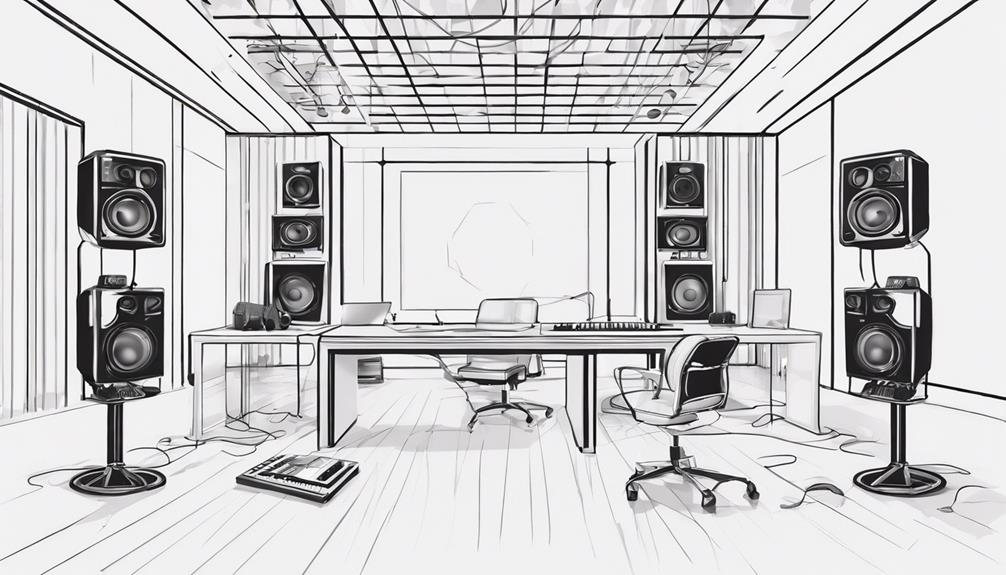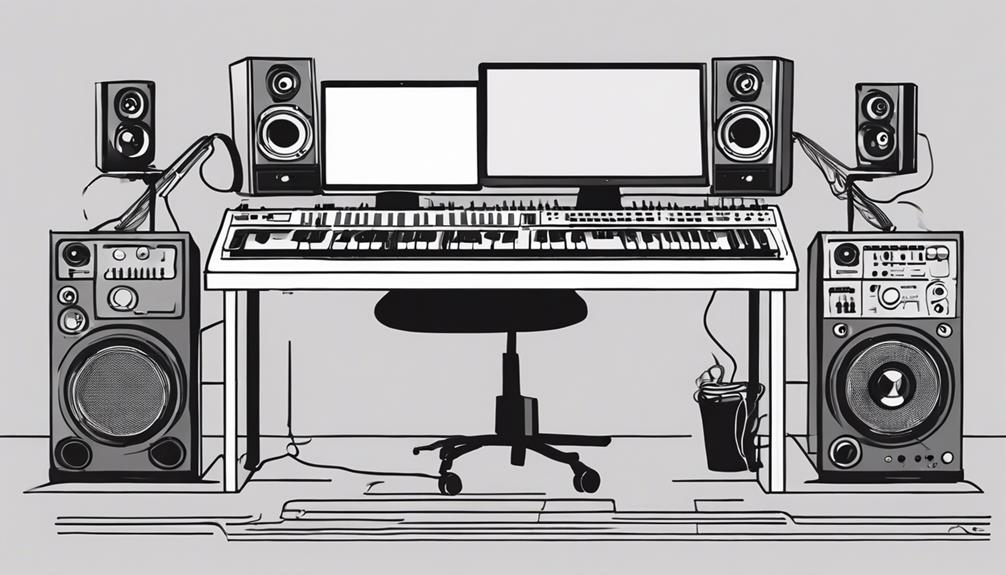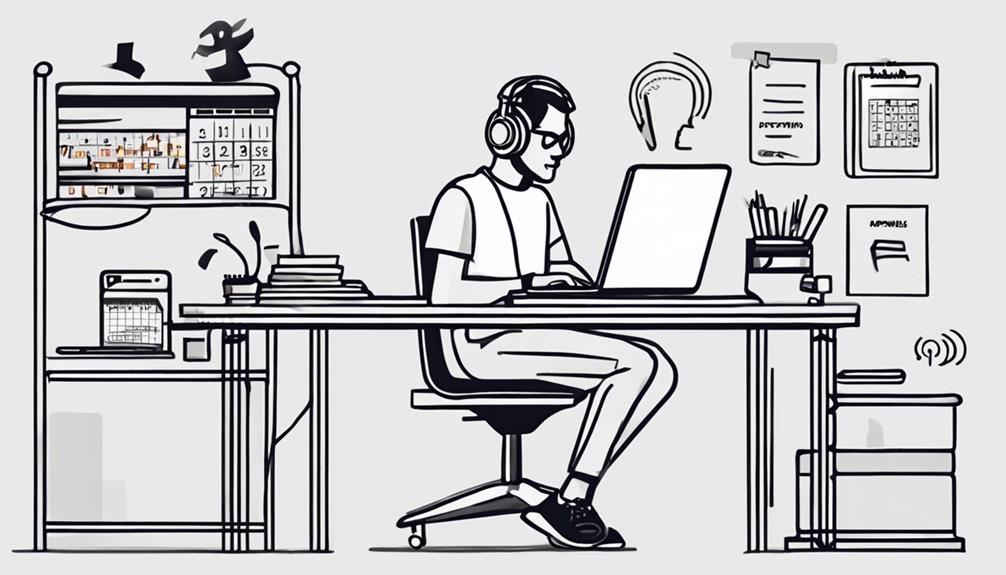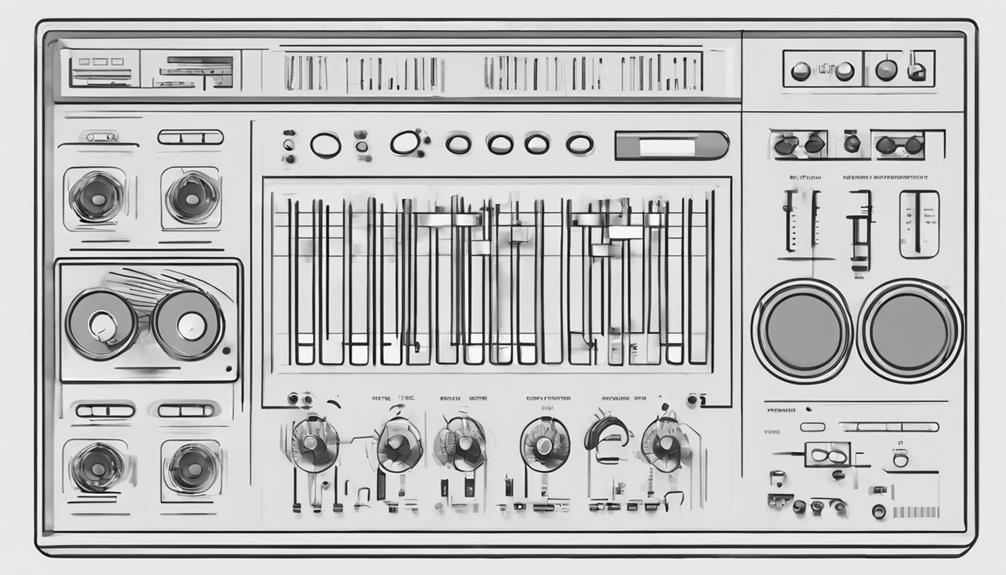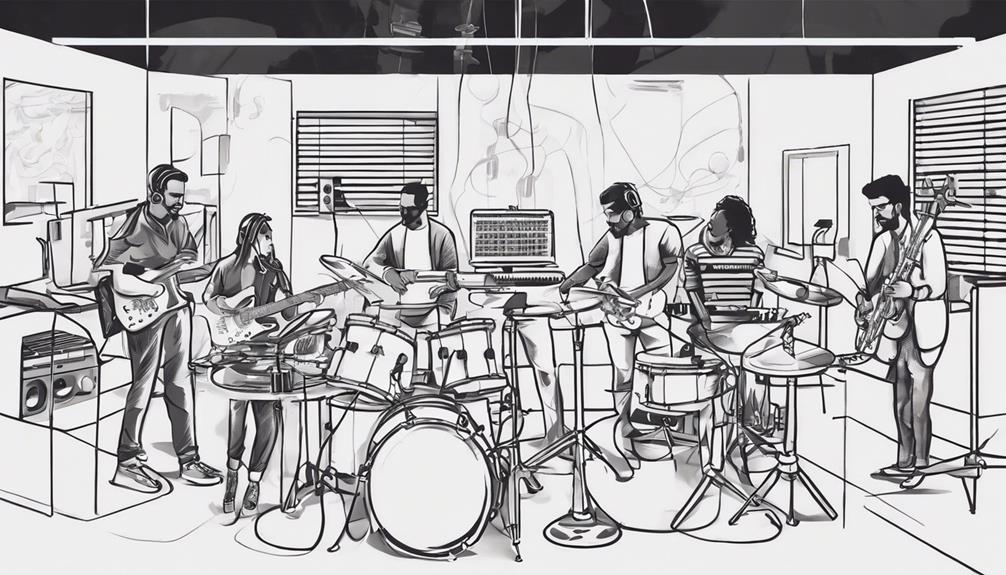To optimize your music production room, start by identifying primary reflection points. Install absorption panels and bass traps to manage sound waves. Utilize diffusion panels for a balanced sound. Position monitors strategically for an excellent listening experience. Adjust trap placement to enhance audio quality. Following room setup guides can be beneficial. Enhance your listening sessions for better music production results. Expert tips on acoustic treatments can take your setup to the next level. Room treatment techniques are key to achieving outstanding sound.
Key Takeaways
- Identify primary reflection points for strategic panel placement.
- Balance absorption and diffusion for an even frequency response.
- Utilize bass traps and absorption panels for sound clarity.
- Optimize speaker placement for immersive sound experiences.
- Seek expert advice for effective room acoustics.
Identifying Primary Reflection Points
To optimize sound quality in your music production room, begin by identifying primary reflection points where sound bounces directly from the source to you, the listener.
These reflections can impact the accuracy and clarity of the sound you hear when mixing or recording music. Common primary reflection points in a room include the walls opposite your speakers and the ceiling above you.
By understanding where these reflections occur, you can strategically place acoustic panels to absorb the sound energy at these points. This helps minimize early reflections that can cause sound coloration and affect the overall quality of your audio.
Addressing primary reflection points is essential for achieving a balanced and accurate listening environment in your music production setup. By tackling these reflections effectively, you can create a space where sound behaves predictably, allowing you to make informed decisions while working on your music projects.
Installing Absorption Panels and Bass Traps
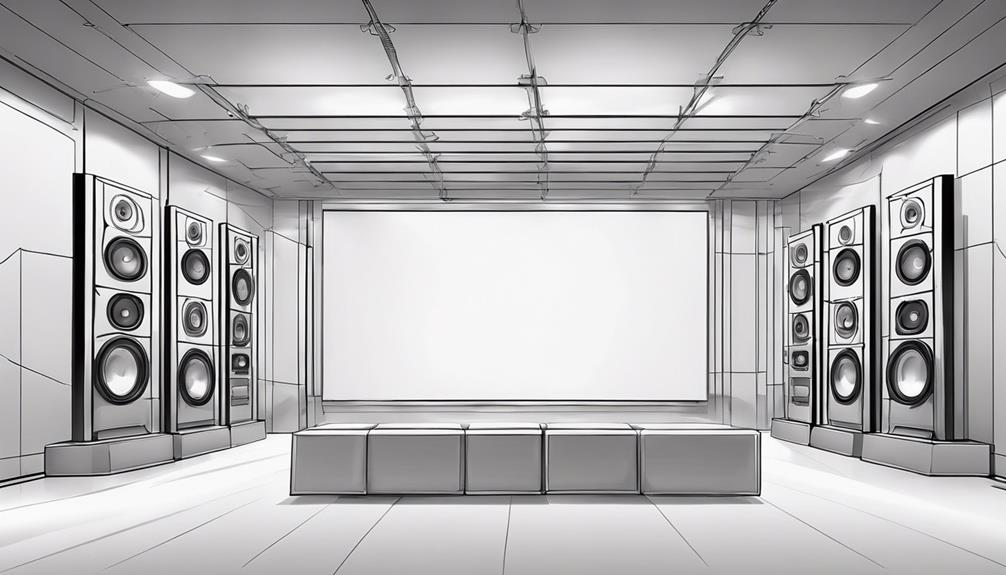
Absorption panels and bass traps play an important role in enhancing the acoustic quality of your music production room by targeting specific sound issues.
Absorption panels are designed to reduce sound reflections and deaden a room's acoustics by absorbing excess sound energy. By strategically placing absorption panels, you can improve the clarity and accuracy of your music recordings and mixes.
On the other hand, bass traps are essential for addressing low-frequency buildup in room corners, preventing muddiness and ensuring a balanced sound.
When combined, absorption panels and bass traps create a harmonious acoustic environment that tackles both high and low-frequency issues effectively.
Additionally, the strategic installation of these acoustic treatments helps in mitigating room resonances, ultimately enhancing the overall quality of your music production and listening experiences.
Make sure to place absorption panels and bass traps thoughtfully to optimize their impact on your room's acoustics.
Utilizing Diffusion Panels Effectively
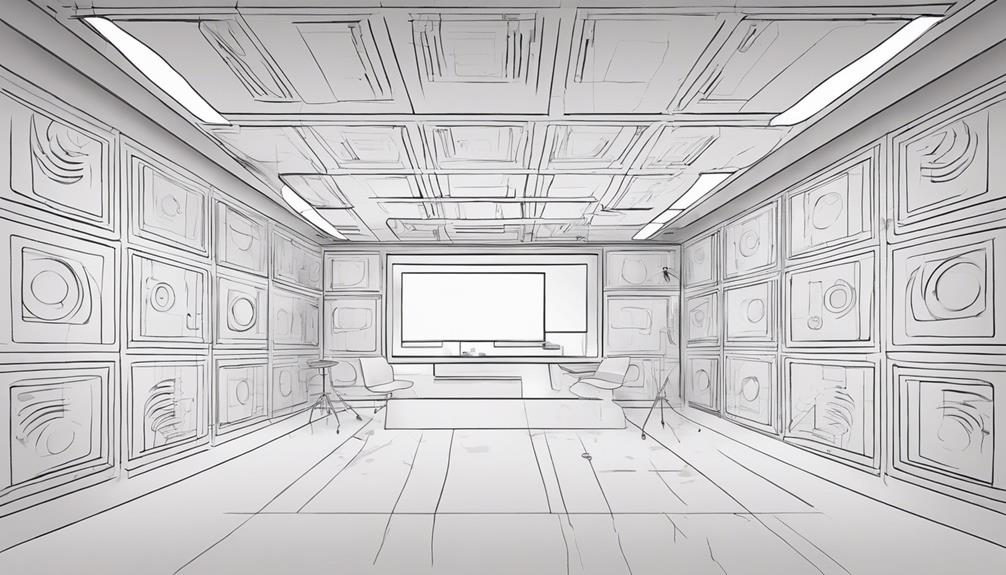
When optimizing your music production room's acoustics, employing diffusion panels effectively can greatly enhance the overall sound quality. Diffusion panels scatter sound reflections, breaking up standing waves and reducing flutter echoes to achieve a more even frequency response.
To make the most of diffusion panels, consider the following tips:
- Scatter Sound Reflections: Utilize diffusion panels to create a sense of spaciousness and natural sound in your room.
- Reduce Standing Waves: Place diffusion panels strategically to help break up standing waves, which can cause unwanted resonances.
- Minimize Flutter Echoes: By scattering sound reflections, diffusion panels can reduce flutter echoes for a smoother sound experience.
- Enhance Frequency Response: Employ diffusion panels on walls opposite the sound source to enhance sound dispersion and achieve a balanced frequency response.
Positioning Monitors for Optimal Sound

Positioning monitors for the best sound in your music production room involves strategic placement to guarantee accurate stereo imaging and frequency response. To achieve this, make sure your monitors are positioned at an equal distance from each other and the listening position, forming an equilateral triangle. This setup helps maintain balanced sound distribution and ideal stereo imaging.
For improved focus and reduced early reflections, angle your monitors slightly inward towards the listening position. Keeping the monitors at ear level while seated is essential to ensure you're experiencing the audio as intended, enhancing the accuracy of your mixes.
To further enhance monitor performance, consider using monitor isolation pads to minimize vibrations and improve clarity, especially in the bass frequencies. Additionally, investing in adjustable monitor stands offers flexibility in monitor positioning, allowing you to fine-tune the sound quality in your workspace.
Adjusting Trap Placement for Balance
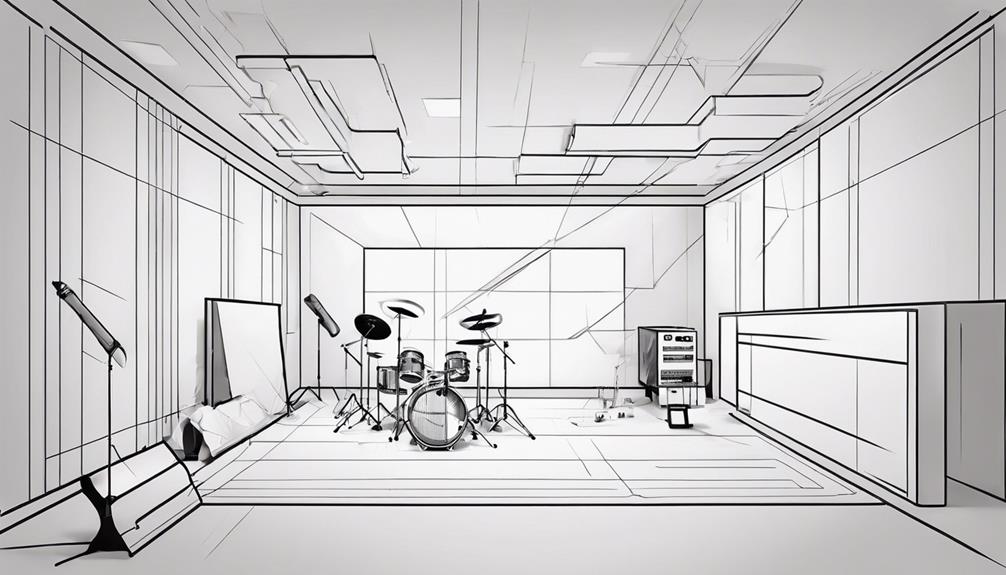
When setting up your music production space, adjusting trap placement is essential for achieving balanced sound. Properly positioning bass traps can greatly impact low-frequency absorption, while wall-mounted absorption panels help control early reflections for clearer audio.
Trap Location Impact
Strategically adjusting the placement of traps in your room can greatly impact the balance of sound frequencies and enhance overall music production quality.
When considering trap location, keep in mind the following:
- Bass Frequencies: Placing traps in room corners can greatly affect bass frequency absorption, helping to prevent low-end buildup and muddiness.
- Sound Balance: Strategic placement of traps at first reflection points can improve sound balance, clarity, and imaging in your recordings.
- Room Acoustics: Balancing trap distribution between corners, walls, and ceiling is important for controlling sound energy paths and optimizing room acoustics effectively.
- Quality Enhancement: Proper trap positioning not only reduces flutter echoes but also enhances sound quality in the mid and high frequencies, providing a more pleasant listening experience.
Experimenting with trap locations allows you to fine-tune your room acoustics, creating a neutral and balanced environment that enhances your music production process.
Balancing Sound Reflections
To achieve ideal balance in sound reflections, focus on adjusting trap placement at key reflection points in your room. By strategically placing traps at early reflection points, you can effectively minimize unwanted echoes and create a more controlled acoustic environment.
It's important to strike a balance between absorption and diffusion when positioning traps to guarantee optimal sound quality in your music production setup.
Utilizing ETC measurements can help you identify these key reflection points and guide you in placing traps effectively. By following these measurements and placing traps strategically, you can enhance the clarity and imaging of your music productions.
Proper trap placement not only improves the acoustics of your room but also contributes to a more professional and polished sound in your recordings. Remember, the careful placement of traps at reflection points is key to achieving the best possible sound quality in your music production space.
Enhancing Room Acoustics
Adjusting trap placement in your room is essential for enhancing room acoustics and achieving a balanced sound for your music productions. When strategically positioning bass traps, diffusers, and absorption panels, you can greatly improve the overall frequency response in your space.
Here are some key tips to help you optimize your room acoustics:
- Bass traps: Place these in room corners to absorb low-frequency buildup and prevent bass from overpowering your mix.
- Diffusers: Strategically position diffusers to scatter sound reflections, creating a more spacious and natural sound environment.
- Absorption panels: Install absorption panels at first reflection points to reduce early reflections and enhance clarity in your music productions.
- Balancing absorption and diffusion: Finding the right balance between absorption and diffusion will help create a more even frequency response in your room, ensuring that your mixes translate well across different playback systems.
Experiment with different trap placements to achieve the best balance for your specific music production needs.
Seeking Guidance From Acoustic Experts

For guidance on treating a room for music production, turning to acoustic experts such as RealTraps and GIK Acoustics is highly recommended. These experts specialize in providing detailed insights into acoustic treatment, offering solutions through their Room Treatment guides.
GIK Acoustics, for example, offers resources like Room EQ Wizard for analyzing room acoustics and determining the best placement for acoustic panels.
RealTraps provides step-by-step instructions on implementing absorption and diffusion techniques to enhance sound quality in your workspace.
Implementing Room Setup Guides
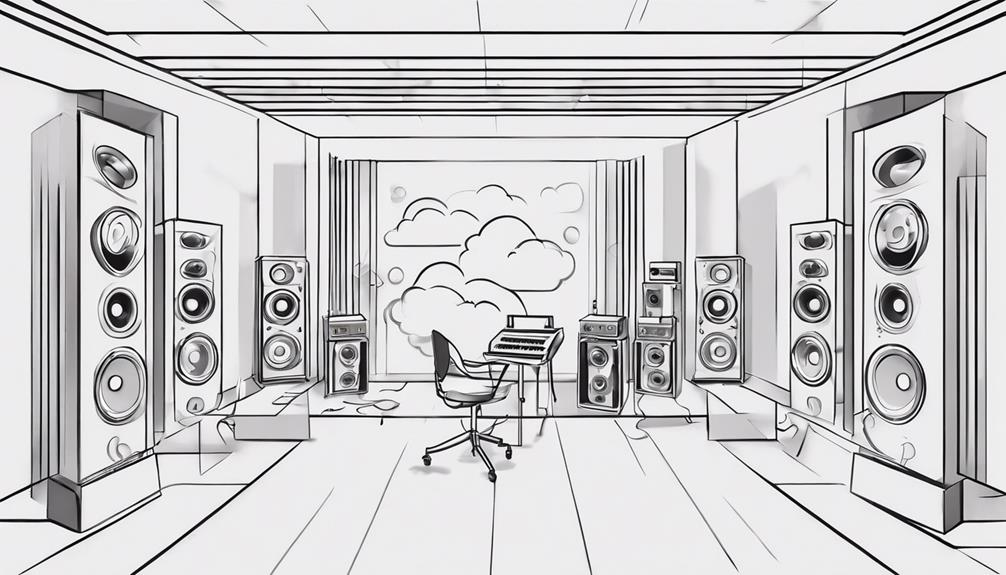
You can begin by focusing on essential room layout techniques and effective sound absorption methods to optimize your music production space.
Positioning your monitors correctly and strategically placing acoustic traps based on room dimensions can notably enhance sound quality.
Understanding these key points will help you create a well-balanced and acoustically treated environment for your music production endeavors. By carefully addressing factors such as sound absorption, diffusion, and bass trapping, you can significantly improve the clarity and accuracy of your audio. This foundation not only enhances your mixing and recording process but also creates a space where creativity can flow effortlessly. Additionally, combining proper acoustic treatment with effective songwriting tips for music producers ensures a productive and inspiring environment for crafting exceptional tracks.
Room Layout Essentials
Implementing room setup guides for music production is crucial for optimizing your room layout and acoustics. To guarantee you set up your music production space effectively, consider the following room layout essentials:
- Acoustic Panels: Strategically place acoustic panels and traps to control sound reflections and enhance room acoustics.
- Room Layout: Follow step-by-step room setup guides from experts like RealTraps and GIK Acoustics to achieve the best acoustic treatment.
- Monitor Positioning: Properly position your monitors for accurate sound monitoring and a balanced listening environment.
- Room Design: Utilize tools like Google SketchUp to efficiently plan and design your music production room for improved workflow and acoustics.
Sound Absorption Techniques
Utilizing recommended room setup guides from experts such as RealTraps and GIK Acoustics guarantees a noticeable improvement in the placement of sound absorption materials for ideal room acoustics. Bass traps play a critical role in absorbing low-frequency energy that tends to accumulate in room corners, preventing unwanted buildup and ensuring a more balanced sound environment.
Porous absorbers like acoustic panels and mineral wool are essential for enhancing sound balance by absorbing excess mid and high-frequency reflections, reducing reverberation, and minimizing flutter echoes. Understanding the distinction between absorption and diffusion techniques is key to achieving a well-rounded acoustic space.
Enhancing the Listening Experience
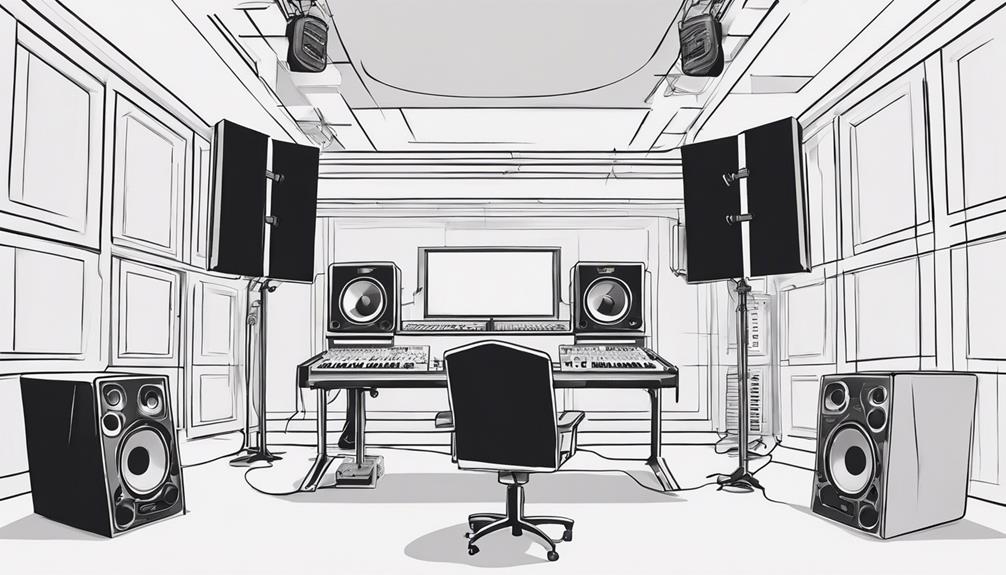
To enhance the listening experience in a room for music production, optimizing speaker placement is essential for creating an immersive sound environment. By strategically positioning your speakers, you can minimize standing waves and early reflections, resulting in a clearer and more detailed sound.
To further enhance your listening experience, consider the following tips:
- Utilize absorption panels: Placing absorption panels strategically can help minimize room reflections, improving clarity in your music production.
- Incorporate diffusion panels: Diffusion panels can enhance stereo imaging and depth perception, creating a more natural and spacious sound.
- Address mirror points: Treating mirror points with absorption materials can prevent sound coloration and enhance the accuracy of your listening environment.
- Install ceiling clouds: Ceiling clouds are effective in managing vertical reflections, which can considerably enhance the overall balance and quality of your listening experience.
Expert Advice on Acoustic Treatments
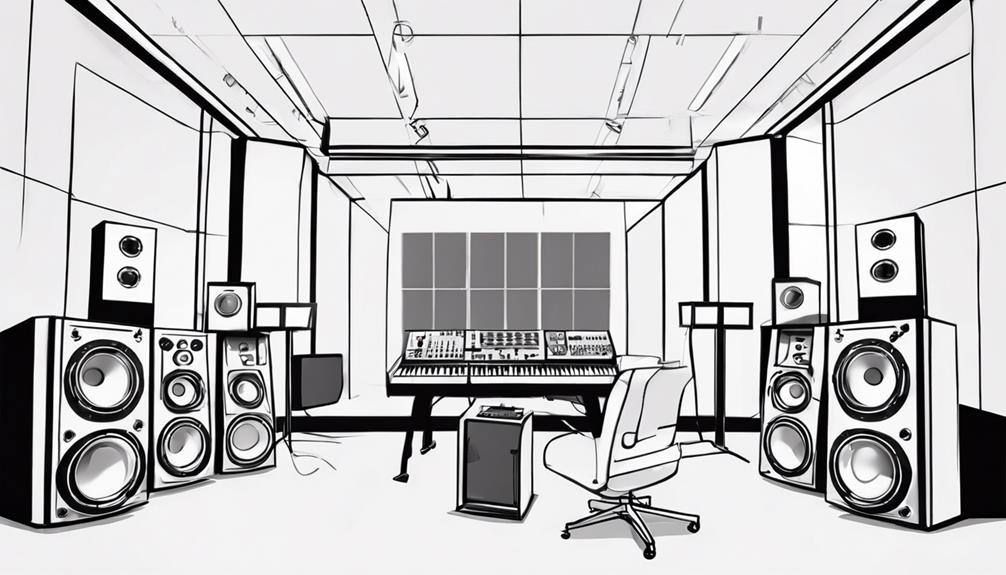
When setting up your room for music production, it's crucial to focus on acoustic panel placement and managing room reflections.
Properly positioning acoustic panels can help control sound absorption and diffusion, leading to a more balanced audio environment.
Acoustic Panel Placement
Consider strategically placing acoustic panels in your room to optimize sound quality for music production. When it comes to panel placement for room treatment, here are some key tips to keep in mind:
- Absorption Panels at First Reflection Points: Reduce early reflections by placing absorption panels at the first reflection points to enhance clarity in your listening environment.
- Diffusers on Rear Walls: Create a more spacious and natural sound field by using diffusers on rear walls to scatter sound energy effectively.
- Bass Traps in Room Corners: Address low-frequency buildup by installing bass traps in room corners, leading to a more balanced frequency response.
- Ceiling Clouds for Vertical Reflections: Control vertical reflections and improve overall acoustics by utilizing ceiling clouds strategically.
Experiment with various panel placements and configurations to strike the perfect balance between absorption and diffusion tailored to your specific room. By following these guidelines, you can notably enhance the acoustics of your music production space.
Room Reflection Management
Strategic placement of acoustic treatments is essential for effectively managing room reflections in music production environments. Early reflections, which can cause sound coloration and reduce clarity, need to be controlled through the careful positioning of acoustic panels and diffusers.
By identifying reflection points in the room and treating them with absorption or diffusion materials, you can achieve a more balanced sound for your music production.
Consider the room geometry and speaker positioning as they greatly influence the level of unwanted reflections. Proper management of room reflections not only improves the overall acoustics of your space but also enhances the accuracy of your monitoring and mixing decisions.
Room Treatment Techniques to Consider
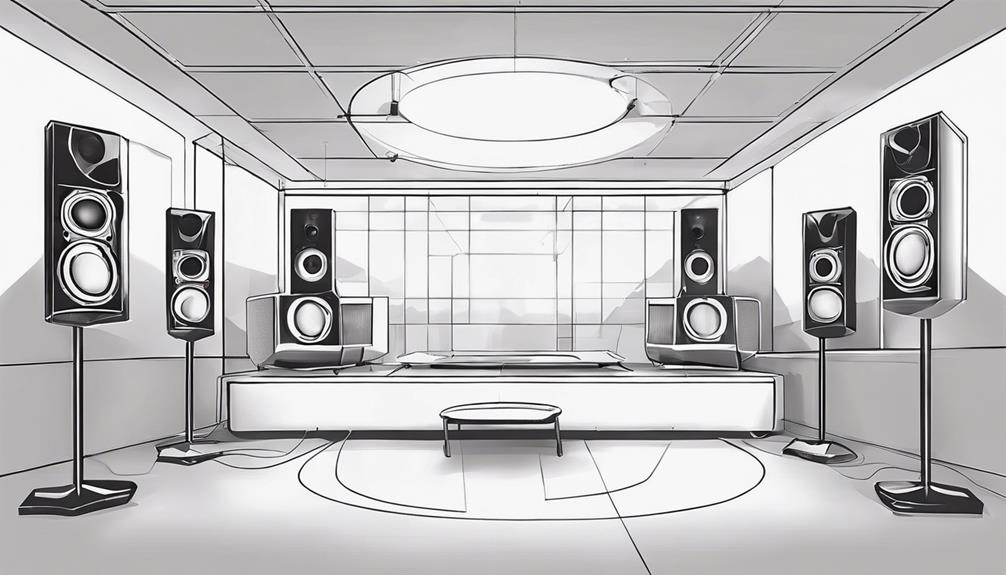
To effectively treat a room for music production, incorporating a combination of absorption and diffusion techniques is essential for achieving a balanced sound environment. When considering room treatment techniques, here are some key strategies to help you optimize your space:
- Utilize Bass Trapping: Combat low-frequency energy buildup in corners by strategically placing bass traps to enhance sound clarity.
- Address Early Reflections: Improve sound quality and stereo imaging by managing early reflections within the room.
- Treat Mirror Points: Reduce unwanted reflections by identifying and treating mirror points where sound reflects most intensely.
- Install Ceiling Clouds: Manage vertical reflections and enhance overall room acoustics by incorporating ceiling clouds into your room treatment plan.
Frequently Asked Questions
How to Soundproof a Room for Music Production?
To soundproof a room for music production, start by using dense materials like mass loaded vinyl or acoustic foam to block external noise. Seal gaps around doors and windows, and consider double glazing windows or adding a second layer of drywall with Green Glue.
How Can I Improve My Room Acoustics for Music?
To improve your room acoustics for music, consider utilizing bass traps in corners and acoustic panels for reflections. Balance absorption and diffusion for even sound distribution. Enhance recording quality with soundproofing measures and software tools for frequency issues.
How Do You Treat a Room for Music Listening?
To treat a room for music listening, position speakers in an equilateral triangle with you, use acoustic panels to absorb reflections, add bass traps in corners, incorporate diffusers for depth, and include carpeting, curtains, and furniture for balanced sound.
How to Acoustically Treat a Room for Mixing?
To acoustically treat a room for mixing, balance absorption and diffusion for even sound distribution. Address early reflections and standing waves. Treat mirror points with absorption panels. Control bass frequencies with bass traps in corners. Manage vertical reflections with ceiling clouds.
Conclusion
Now that you've mastered the art of treating a room for music production, you're practically a sound wizard! Remember, proper acoustic treatment is key to achieving that perfect mix.
So go ahead, cover those walls with panels, position those monitors just right, and bask in the glory of your beautifully balanced sound.
You're basically a rockstar in the world of room acoustics now!

